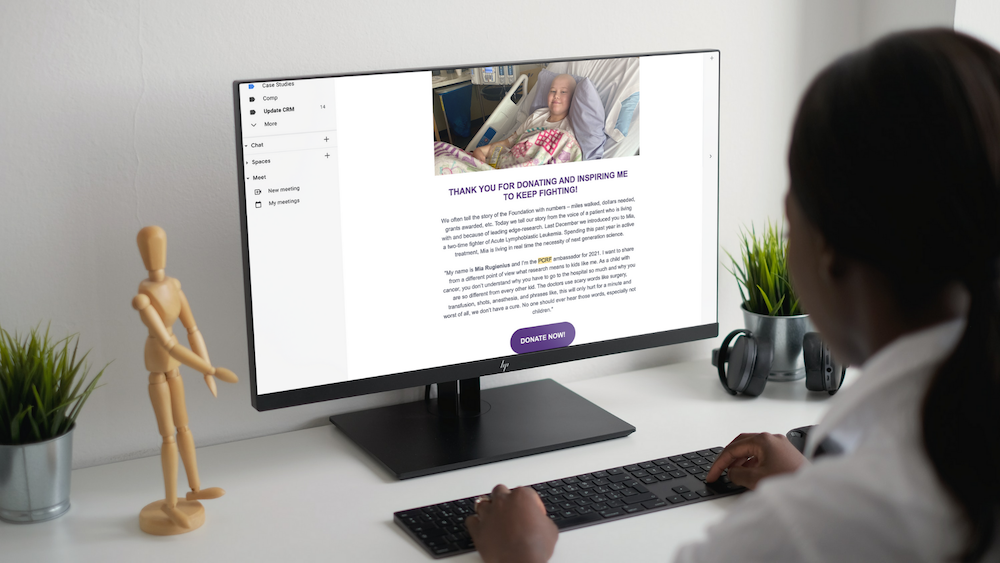
26 examples for segmenting your nonprofit’s audience
Segmentation is the process of breaking up audiences into unique groups (or segments) where they can be served only the most relevant content and communications. For example, a member will respond differently than a non member or first time website visitor. And a long-time donor would be confused if they received an email meant for a volunteer.
Defining groups that take into account the context and intent of its members helps Good marketers serve only the right content to the right people. Serving the right message at the right time to the wrong person doesn’t get anyone very far. So starting with the right person in mind — through segmentation — sets your marketing campaigns up for success.
Relevancy is better than reach
In marketing, and especially when cultivating connections with your audience, relevancy always counts more than reach. If you reach 100,000 people with great content that’s beautifully designed, it’s all for nothing if those people aren’t the right folks.
On the flip side, if you reach 100 people who are the right people with the right content for them, then you’re going to get great results. And this is what the best marketers are aiming for: results.
Taking segmentation a step further
A lot of organizations simply divide their audiences by demographic information. And this is a good place to start. But with modern digital tools for tracking and engaging audiences, this is just step one.
Every piece of data about the context (what you know about your audience and what your audience knows about you) and intent (what your audience plans to do) of your audience should be used to meaningfully connect with these people.
This can be about the channel that they found you on: LinkedIn, Instagram, TikTok. Or it could be based on the location where they live: New York or Los Angeles or Topeka, Kansas. Or it could be based on their recent or past behaviors: lapsed donors or someone who made it to the donation page or registration page for the first time but didn’t donate or register.
One other lens to keep in mind is the programming that drew someone into your organization. If they’re particularly concerned with advocacy, then make sure your communications with that person focus on their values. Or if they’ve only attended your events, focus on what matters to that group.
Segmentation in action
Let’s dive into some examples of ways your nonprofit can segment its audience! Depending on your nonprofit, not every example will apply, so we’ve organized it so: 1 – 9 are all about donors, 10 – 15 are all about memberships, 16 – 23 talk through stakeholder groups, and 24 – 26 zooms out toward the public:
1. Major donors
This one’s easy. If you’re a nonprofit that receives funding primarily through philanthropic giving, knowing who your biggest donors are is key to continuing and expanding those relationships.
This group can even be further divided into segments based on what channels they prefer and the regularity they expect to receive communications. Or they can be grouped by states or cities — whatever best helps your organization speak meaningfully to them.
Because this group is so important for many nonprofits, it’s essential to meet these individuals the way they expect and prefer.
Some people like seeing a lot of emails from your organization while others may just need one email at the end of the year. Segmenting your major donors is step one before you begin to find additional nuance in how to cultivate and activate this very important segment.
2. Small gifts
Just because someone gave a small gift doesn’t mean they’re always going to give small gifts. Brady Josephson, VP of charity: water, recently spoke with the Feathr team, and he thinks one of the biggest drivers for charity: water’s success has been the care and investment they’ve put into their relationships with every single donor.
Not only do many smaller donors become bigger donors over time, but also a lot of small gifts add up over time. Investing in this often neglected segment can be the difference between retaining and growing gift sizes and staying stagnant.
So many nonprofits are so focused on new donors that they forget that many of their previous donors have a lot more they plan and desire to give.
3. Recurring donors
It would be strange to send an email or serve an ad asking a recurring donor to make a similar gift to the one they just gave a day before. But asking this group to increase the size of their recurring gift or simply updating them regularly about the impact that their consistent giving makes can go a long way.
Like every donor, recurring donors aren’t simply some revenue number, they’re people! And because they’re people, they want to know where their money is going and how they’re impacting the world through their partnership with your organization.
A thank you goes a long way, but getting specific about the positive change that people’s gifts are making helps them see the value of giving again, and it will be critical information when they consider increasing their gift size.
4. First time donors
No matter the size of the gift, this is a uniquely important group to follow up with. So much of a relationship is based on first impressions, and if a first-time donor doesn’t feel valued from day one or week one, it’s going to be a lot harder to win them back after six months or a year.
Again, thanking these first time donors and showing them the change they’ve already made in the world is essential in turning first time donors into recurring donors or major donors. Rome wasn’t built in a day, and most donors don’t jump immediately into the major donor bucket.
Central to the effectiveness of segmentation is the idea that it’s a person that’s being reached out to. And this means that someone isn’t stuck in the bucket, or segment, that they started out in. If we think people don’t change — that a small donor or first-time donor is stuck where they are — we’ll probably act that way and reinforce their action. And this is self defeating.
People change, which means that donors change, and by treating them as partners and agents of impact, nonprofits can better serve these people and expand the reach of their organization.
5. Lapsed donors
It’s easy to see how this segment can be valuable for a nonprofit to follow up with. Lapsed donors clearly have the intent to donate because they’ve done so in the past. Because of this, cultivation of this group doesn’t require a ton of time before activation.
A well-placed ad or timely email may be all that’s needed to bring someone back into the fold. And often the best marketing isn’t about novelty or the shiniest new social platform. It’s about first picking up the low-hanging fruit.

Lapsed donors are one of the best segments to target for quick results, but we think this next group might be the absolute best place to start when you’re segmenting donor groups.
6. Donation abandoners
These people have yet to give to your organization, but it’s clear that they have intent based on the fact that they made it all the way to the donation page on your website.
With the right software, you can serve this group ads reminding them to complete what they already intended to do. Maybe they had to jump into a meeting or had a call come in, or maybe it was just that their wallet was on the other side of the house.
Whatever it is that stopped them, a friendly nudge back to your website might be all it takes. If possible, reach this group through multiple channels. Ads can follow them across the web while an email might be the most personal way of following up.
7. Current ideal donors
Creating a segment based on your ideal current donors can shed a lot of light on who you want to look for going forward. A lot of nonprofits create a list of major donors and consider the task complete, but after looking a little closer at the findings, many nonprofits will discover that ideal isn’t only about the size of the gift.
What’s often more important is the relationship and engagement a donor has with your organization. If they’re fully on board with your mission, they’ll more likely be a more committed and consistent donor and spokesperson. Having people who truly champion your cause is often worth more than the extra dollars.
And in the process of defining your current ideal donors, you may begin to see patterns that can help lead you to the next segment.
8. Target donors
These are people that you want to join the cause. It’s important that this not be just a pie-in-the-sky wish list. Your team should have every expectation of reaching and engaging a large portion of this segment, and someone shouldn’t be on the list if it doesn’t feel realistic for that person to get on board.
This segment should be carefully built through pulling together insights from your CRM. Your current ideal donors will tell you a lot about who you’ll want to look for in the future, and you can even use that list to find similar audiences through lookalike campaigns. But you should also do research based on your intuition and organizational goals.
Donors are people, and deciding who to spend time with is a relational decision, so it shouldn’t only be about demographic or behavioral similarities. Don’t overlook that target donors are ultimately people that you want to invest time and energy into.
Jon McCoy at We are for Good, said, “Donor behavior matters more than giving.” So make sure this list goes deeper than just a number. Having supporters that are actively pushing your organization forward through sheer passion counts a lot more than a one-time gift — even if it’s really big.
9. New donors
One important thing to remember about segments is that you don’t have to have their contact information on hand before identifying them as an important group. It’s actually helpful if you identify a segment before you begin to build out the contacts on that list so that you aren’t confined to your current lists. And that’s exactly where new donors fit it.
While partnering with nonprofits, we’ve seen so many nonprofits want to reach new donors, but it’s so important to have a game plan for doing so. Good marketing will have a huge impact on helping your organization understand, cultivate, and activate these new relationships.
At least compared to the last eight segments, this one is the most nebulous. It doesn’t mean that you can’t go after unknown audiences to begin to cultivate them toward joining the cause, but a donation from an entirely new person often takes time, and it shouldn’t be the expectation that someone will give the first week they come in contact with your organization.
Awareness campaigns like geofencing or search keyword campaigns are excellent ways to get in front of new donors, but often the process of turning those new people who just became aware of your mission requires time and cultivation.
Rome wasn’t built in a day, and no relationship is built off a first impression. First impressions matter, and taking the risk to initiate those new conversations is necessary, but nonprofits need to be ready to play the long game, investing and caring for these new people before expecting a gift or donation.
10. Current members
Shifting focus to organizations that are built on memberships, building a segment with all current members is a great step for maintaining engagement with your current base. Retaining members doesn’t happen accidentally, so intentionally following up and keeping this essential group in the know should be the foundation that your team builds on for the future.
Marketing is often equated as simply a campaign. But every touch point that a person has with your organization influences their perception of your brand and organization. And because of this, all these different experiences need to be orchestrated in a way that they tell a compelling story about your organization.
Invest time and energy into cultivating the members that you currently serve. Their experience is central to all your marketing efforts.
11. Long-time members
These people have been with your organization for a long time. They’re the true backbone of your team. Make sure you don’t take them for granted!
Plan ways to thank them for their sustained support, and create exclusive events and experiences that show them how much you value and appreciate them.
In terms of word of mouth, these people will have a lot of power in communicating your organization’s mission and purpose because they’ve been with you for a while and they really know what you’re all about.
12. First-year members
New members need to feel special too. Just because someone signed up for a year with your organization doesn’t mean that you’ve won them over for life.
But this group doesn’t require as much effort from your team as acquiring entirely new members, so think of this as a strategic way of picking up the low-hanging fruit.
Your organization is missing out if you don’t specifically spend time winning over this group of new members. They’re already yours, but if they feel unappreciated, they may not stay for long.
13. Lapsed members
Just because someone didn’t renew, doesn’t mean that they don’t like you anymore. They could have simply forgotten, or changed credit cards or a phone number, or maybe they were going through a rough time in their life and they needed to cut back for a moment.
Whatever reason someone left, don’t allow it to keep you from following up. Something drew these people to you in the first place, so there must be something there. By offering them the right deal or listening to what’s changed in their life, you may be able to win back these people who already know the amazing work your organization does.
14. Target members
Creating a list of people that you want to join your organization is key for setting up for the future. Everyone needs ambitious goals that are still realistic. And knowing who you want to join your team is a great way to fire up the membership team.
You may focus primarily on your larger membership tiers, but you should spend time thinking about who in those tiers are the MVPs. If the 80/20 rule applies at your organization, then 20% of your donors are making 80% of the impact.
Paying close attention to who’s getting in the way of the mission and who’s pushing it forward is always more than just counting membership dues.
15. New members
This segment is similar to new donors in that you may not already have a list in place to go off of. But this is still a great segment because you’re identifying a group that you want to understand, cultivate, and activate. If all of your segments are built off of current lists, then your organization is ultimately limiting its growth opportunities.
While retention can be a cost-effective way to keep revenue up in a hard year, gaining new members will always be a priority for growing organizations. And yours needs to think of creative ways to capture attention.
People who visited your website and learned about memberships, but still haven’t joined yet, are prime for receiving a follow-up email or a well-placed ad. Think of creative ways to get someone through the door for the first time. Give them a special offer or create something that’s built specifically for people exploring membership.
Everyone wants to feel special or like they’re getting a great deal. If someone feels like they’re valued when they’re visiting for the first time, I can almost guarantee they’ll be back again.
16. Supporters
Just because someone doesn’t give or volunteer doesn’t mean they aren’t a huge asset for your organization. Anyone who supports your work should be recognized and invested in.
Some of your supporters may have huge social media followings, and it may only require a small nudge to have them post about your upcoming event or donation drive.
Making people feel special because of their unique value to your organization is what segmenting is all about. Your supporters want to champion your cause, so make sure that they have all the important information that way they can share it with the rest of the world.
17. Volunteers
One of our first examples was the difference between your major donors and your volunteers. Both groups fill essential roles in your organization, but if you make a donation appeal to a volunteer, they may question their value. Just like a major donor may question their value if they don’t have enough time to volunteer.
Engaging with volunteers about opportunities that match their unique skill sets or opens up future career opportunities for them is essential in recruiting and retaining this key segment.
But like a lot of other segments, starting with gratitude is key. Time is something all of us only have a finite amount of, so sharing what a difference their time makes for your organization is always step one.
18. Internal staff
We often have this idea that marketing is always externally focused. But building momentum inside of the organization is key to reaching the market. So don’t forget that it requires a team to reach the world!
Giving other departments insights into movements that are going on with your own team can be an encouragement and challenge to keep pace. Marketing, more than any other department, has a unique capacity of crafting and sharing stories that shift perspectives and spur results.
Don’t point everything outward. Spend some time crafting messages to excite your peers and organization as a whole. The best work always happens when everyone works together.
19. Board members
While talking about staff, it’s important to also consider your leadership team and board members. These people are directing the ship, and so sharing your story with them can have strategic implications for your organization.
Make sure to give board members a look behind the curtain as they know the basics already. The more detailed your findings and the more nuanced your data the better. Even a small amount of investment in communications toward board members can go a long way in spreading the message as well as steering the ship.
20. All stakeholders
Think about everyone who’s invested in your organization's success. Sometimes the biggest wins for your organization are meant to be shared by everyone involved.
Spreading the news about a particularly moving story or getting all hands on deck for a challenging project may need to go out to everyone at once.
Even though this is close to general messaging, these people do know something about your organization and mission, so this group is more prone to share in a big win or want stay up to date on a shift in priorities.
21. Clients
Communicating with your clients is just as important as speaking with your biggest donors. These are the people that you exist to serve. So they should feel appreciated in every communication that you have with them.
It’s especially important to have this as a segment so that you don’t accidentally send them communications that were meant for your biggest donors or volunteers. It could be awkward asking clients to donate to support their own impact story.
22. New clients
Marketing and segmentation can be just as effective for finding new clients to serve as it can be for finding new donors, volunteers, supporters, or members.
If your organization has a service but you’re looking for additional qualified recipients, it may be time to create a segment of people that you want to consider your service.
The first job is always to serve your current clients as well as you can, but a part of the budget should also go toward growth, and knowing who you want to serve is essential for growth-minded nonprofits.
23. Patrons / Beneficiaries
Some nonprofits serve groups that aren’t clients and may not be at a place to even consider themselves stakeholders yet.
Think of first-time visitors to a museum or attendees of a local theater’s opera. These people have benefited from your programs and may not even know the many opportunities that you offer to expand their engagement.
If they just visited for the first time, following up when you have an exciting new event or even seeing if they’re aware of programming similar to what first drew them to you can be especially powerful.
Drawing someone back is always easier than finding someone entirely new. And an added benefit is that they already know about the amazing work that you do.
24. Local population
There are a lot of reasons why you may only want to follow up with people in a specific location. If you’re a local nonprofit that serves a specific area, it usually isn’t in your best interest to reach out to people who are outside your region.
Or maybe you’re a larger nonprofit that serves the entire country, and you’re planning an event in Texas. You’ll want to send unique messages to Texans who live close to the event as they have a unique opportunity to attend. Especially as it gets closer to the day of the event, offering last-minute deals to locals may be the secret to making the most of your event.
25. Unknown website visitors
This is a unique group because you actually do know a little bit about them if you’ve set up your website properly. With Feathr ID or a similar tool, you can now make use of this group that was once just a complete unknown.
You can even know what pages these visitors went to and serve ads following up on the specific program that attracted them. If they landed on an event page, you can follow up with an email or ad telling them about an early-bird special. Or if they landed on a donation page, but failed to make a donation, you can follow up with an invitation to complete their donation.
26. General public
This one almost feels like the opposite of everything we’ve been saying so far. But even though we think general messaging has lost some of its effectiveness, that doesn’t mean that there’s never an opportunity to reach out to a broader audience.
Think about small steps that you can invite people to take to get to know your organization. Or even think of novel ways of capturing attention. Just don’t count on going viral tomorrow. It’s always better to create a game plan that has proper expectations instead of just hoping for the best.
The key takeaway
This list was built to be as exhaustive as it could be, but because your audience is unique from every other audience, your segments will also be different from every other organization’s. Finding the right way to break up your audience into meaningful groups will be primarily about understanding the context and intent of your community.
Feathr has partnered with over 1,300 nonprofit organizations, helping them understand and cultivate their audiences. Reach out if you want to talk with a Good Marketing Strategist about how to segment and engage more meaningfully with your organization’s audiences!
You May Also Like
These Related Stories

The 3 Crucial Segments to Automate for Every Event

Turning holiday donors into lifelong supporters

